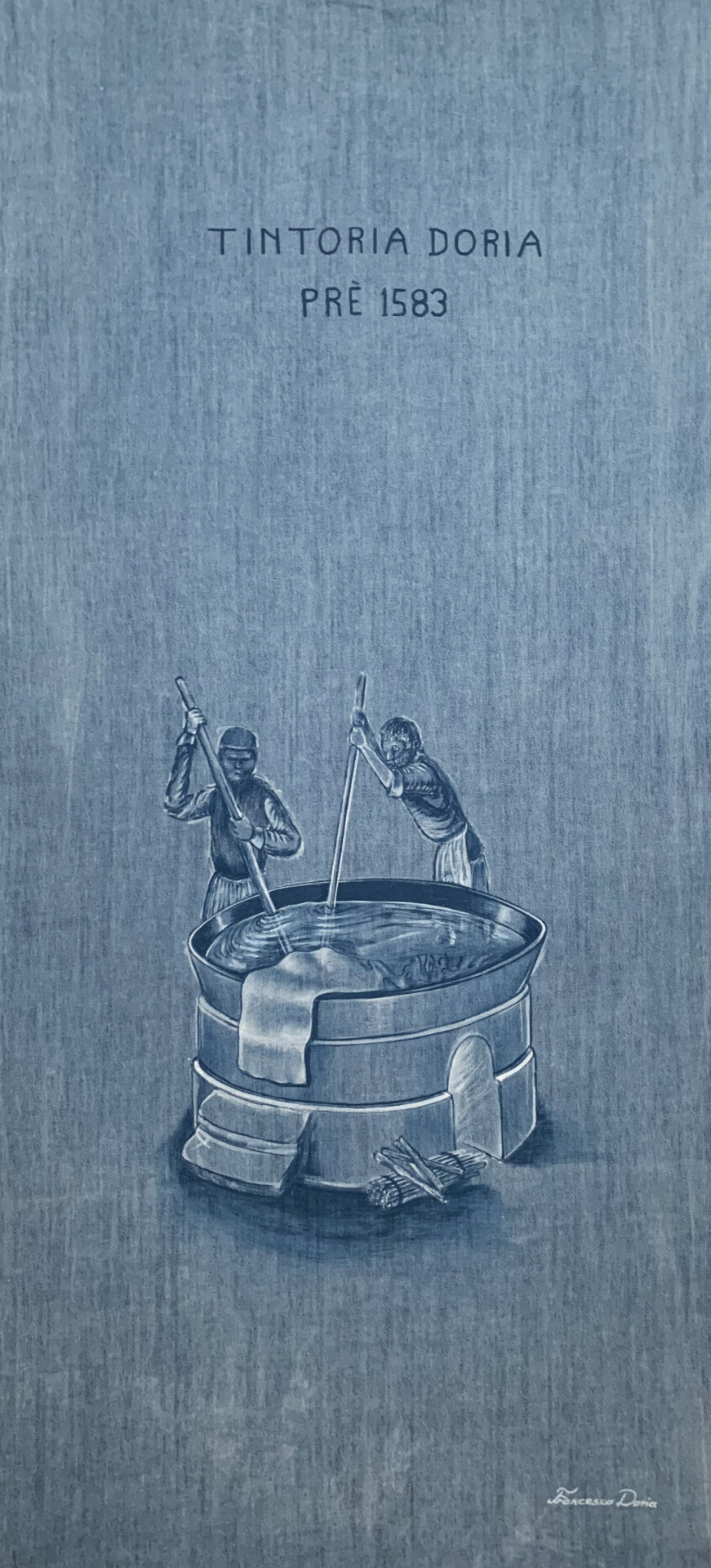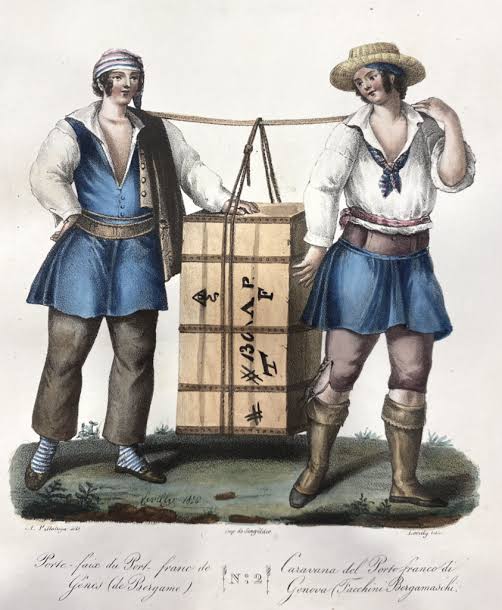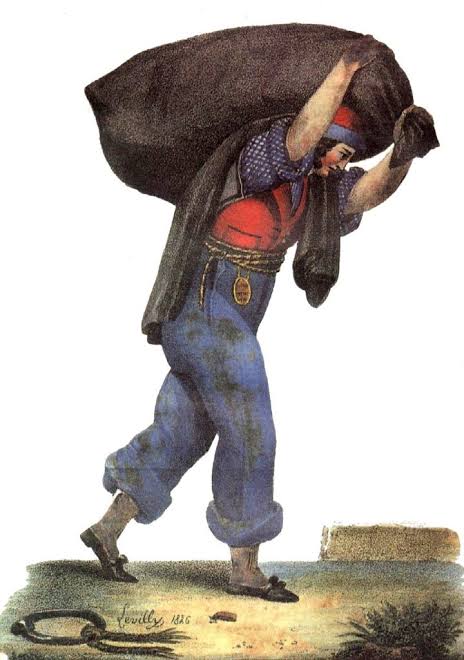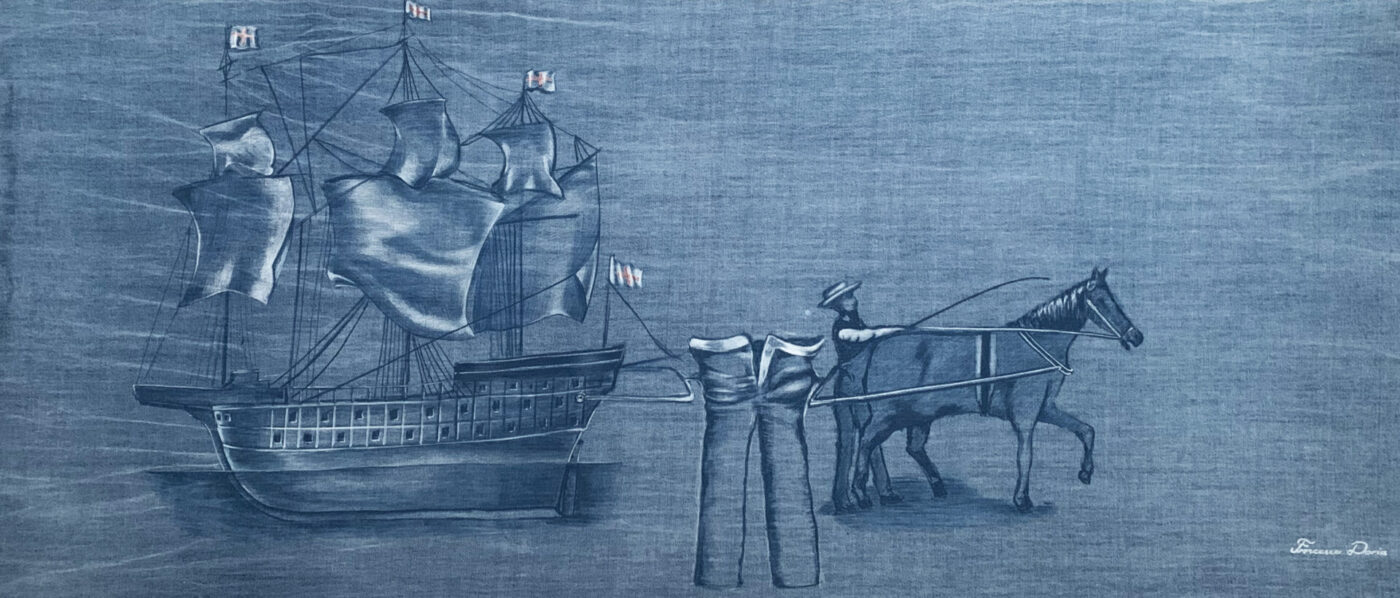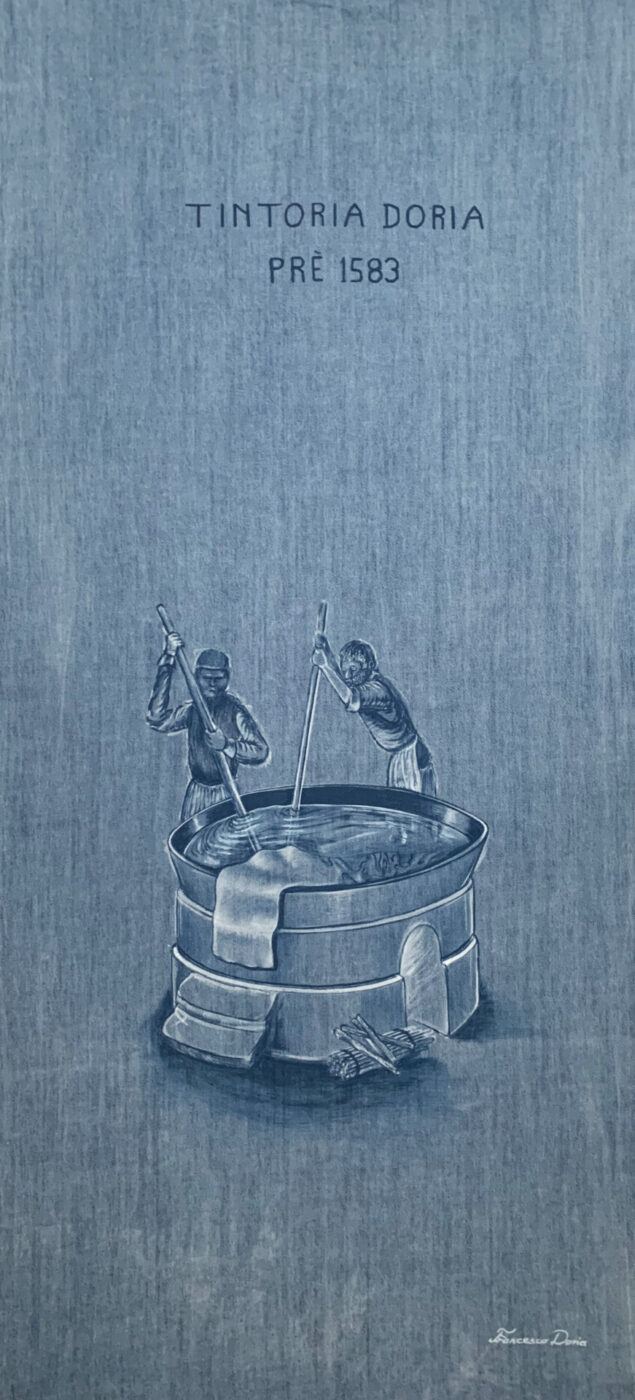The next time you pass a statue of Italian general Giuseppe Garibaldi–of which there are many–take a moment to focus on this distinguished icon: he’s lent his name to a red wool shirt, predecessor of the blouse, as well as a beard style, but look beyond, to his bottom half, and you just might find he’s actually wearing jeans. Jeans? In the 1800s? Outrageous. Alas, history tells us that Commander Garibaldi once took to the high seas wearing a pair of pants made from the same type of blue woven cotton fabric you’re most likely wearing right now, a fabric that is part of a centuries-long legacy belonging to Liguria’s capital city. Garibaldi’s pants, your pants, the most-worn garment in the world, are deeply woven into the cultural and creative fabric of Genova (all puns intended).
Truth be told, Genova has had the blues since the 16th century, at least. Jeans originated in the bustling port city (which was once the world’s wealthiest commercial harbor) where a robust cotton cloth was first produced and dyed with indigo blue pigment, used by shipbuilders, merchants, and sailors as a cheap, robust, and durable material. This means ship sails were made of “jeans”, protective coverings for precious goods were made of “jeans”, and, it was quickly discovered, “jeans” could be used to make nifty types of blue work pants that could withstand the wear and tear of an honest day’s labor. Strolling along Genova’s Porto Antico today, you’ll see jeans in every which way: ripped, faded, cuffed, studded, cropped… accidentally stained with a certain green pesto. But back then, jeans were jeans, no back-pocket labels, frills, or other embellishments. The first-ever pairs of jeans worn in Genova and around the region of Liguria represent an ancient Italian legacy of production and utility mixed with geography, a legacy that far (far) transcends the realm of fashion.
That’s why jeans means Genova…literally. Many of us use the terms “denim” and “jeans” interchangeably today, but let’s be crystal clear: “jeans” refers to the sturdy cotton twill fabric first produced in Janne (the old French word for Genoa), which was eventually exported to England and America, while also making its way throughout Liguria and to the rest of Italy. “Denim” comes from “de Nîmes” (meaning “of Nîmes”, a city in southern France), where a similar durable cloth was woven from wool and cotton in the late 17th century. By many accounts, this French denim wasn’t blue. Genova’s however, was an instantly recognisable shade of blue thanks to a specific indigo pigment (Indigofera Tinctoria). And so the fabric was exported under the French name “bleu de Gênes”, from which comes our beloved “blue jeans”. Relax, nobody is going to arrest you if you ask to buy some “denim” in Genova today (though one might respond with the bluntness the population is known for). But keep in mind the historical, cultural, and linguistic significance of blue jeans–a name of French origin, for a Genovese invention, that would one day become the most-worn, most-loved garment in the whole world.
But let’s take a few steps back, even before our friends Garibaldi and the jeans-clad Genovese sailors and merchants. In her book The history of Jeans. From the origins to the legendary Blue-Jeans, Monica Bruzzone, a celebrated jeans scholar and author, writes of the Telli della Passione (The Passion Cloths), an artistic Medieval precursor to jeans: “the oldest and most illustrious ancestors of jeans…a truly unique series of 14 moleskin cloths dyed indigo blue mixed with white lead, depicting the stories of the Passion of the Christ.” Currently hanging in the dim depths of Genova’s Museo Diocesano, these Passion Cloths (the first cycle, dated between 1538 and 1540, was produced by late-renaissance painter Teramo Piaggio) are precious proof of the fact that jeans have long been a creative “canvas” inherent in the city’s identity. Experiencing these works up close is rather like a surreal collision of socio-historical time frames: floor-to ceiling lengths of blue jeans dyed with intricate scenes of Christ’s betrayal, flagellation, and burial. They are of course ancient, but yet, strangely modern, given their alluring texture and surface sheen.

Fashion icon and jean wearer Garibaldi
Bruzzone and other jeans scholars including Clelia Firpo and Marzia Cataldi Gallo have extensively documented the history of blue jeans in Genova, in Liguria, and far beyond, noting other early records of the fabric’s evolution into “popular clothing” as seen in 18th-century presepe statues (a nativity scene or Christmas crib) and in late 19th-century watercolor illustrations by artist Alessio Pittaluga depicting il popolo Ligure (the Ligurian people) dressed in folk costumes made of, you guessed it, blue Jeans. Even the likes of Giuseppe Garibaldi, as mentioned, cottoned on pretty quickly, opting for blue jean trousers when he departed for a major expedition from Genova in 1860 wearing what Bruzzone described as “…what might have been the oldest jeans in the world.” In that same year, he also appeared on the balcony of Palazzo Doria d’Angri in Naples to announce the annexation of the Kingdom of the Two Sicilies to Italy. What was he wearing? Loose pants and a necktie made of jeans. If Commander Garibaldi and company ever found out that some of you are forking out upwards of 300 euros for a single pair of blue jeans today, there’d be eyebrows raised, no doubt.
Just when I think I’ve hit the jeans jackpot after a productive research trip to the city where it all started, I meet, by chance, a Genovese gentleman and artist in Milan by the name of Francesco Doria Lamba; yes, Doria, as in the aforementioned Palazzo Doria d’Angri. He just happens to be a descendent of the highly influential Genovese Doria family, who played a vital role in the history of the Republic of Genova (and beyond) from the 12th to 16th century. Doria Lamba has blue jeans in his veins: his ancestor, Brancaleone Doria, was one of the first to import the blue indigo pigment into Genova from the Orient in the late 1400s. This personal historical connection to jeans has inspired Doria Lamba to not only explore the fabric as the basis of his art practice, but also to reinterpret key aspects of this ancestral jeans narrative in visual form. He is, therefore, the ultimate jeans spokesperson, with a vision to spread global awareness about the fabric’s origins in his home city. “Everyone in the world knows jeans, but not everyone knows Genova,” Doria Lamba tells me. Musing on the significance of blue jeans from a multitude of intriguing social, creative, and cultural perspectives, he continues, “The thing that indigo did, I think, was democratise the idea of blue garments, especially in art and culture. Prior to indigo, lapis lazuli was used in paintings by artists like Giotto, and, whenever this blue appeared, it was to signify a royal or a holy figure. Once people from the working classes started to wear jeans dyed with indigo blue, the colour became identified with, and ‘accessible’ to, a broader variety of social classes.”
Digging through the Doria family’s archives in Genova’s Archivio di Stato, the artist has found trading receipts from his ancestors, who were some of Genova’s first producers of blue jeans, following Brancaleone importing the indigo pigment. “History isn’t written by traders, but these receipts are proof that jean production definitely has its origins in Genova,” he says.
Elegant and emotive, Doria Lamba’s own art compositions resemble contemporary visions of Piaggio’s Telli della Passione, using jean fabric as the base “canvas.” His works are a homage to both the historical significance of jeans from his birthplace, and to its enduring symbolic resonance. He has an innate feeling for the fabric, as well as its capacity to evoke social and cultural truths and realities, and I find that Francesco Doria Lamba is the jackpot–the embodiment of Genova’s jeans narrative, which continues to evolve in today’s generation.
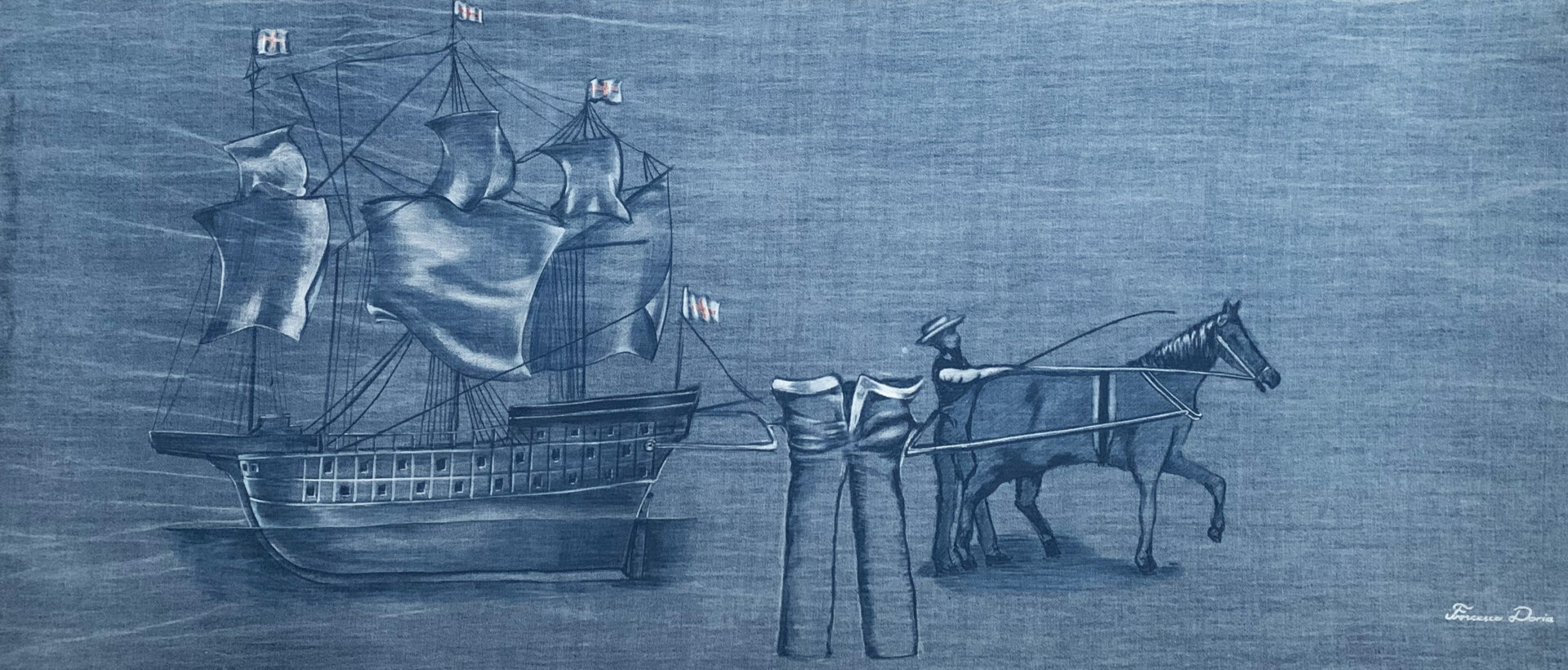
Art by Francesco Doria Lamba
So the question is, when discussing the socio-cultural legacy of jeans today, why does America come up before Italy? Why does James Dean come to mind before Fabrizio de André (the Genovese singer who released an album cover in 1980 capturing the iconic stitching on a blue jean jacket)? Why aren’t blue jeans celebrated as one of the most gracious gifts to humankind ever to come out of the Ligurian region? Of course, the likes of Levi Strauss (and the invention of jean rivets and pockets), cowboys, glossy magazines, and Hollywood meant the commercial and social success of Jeans was, and still is, attributed to America–despite the eventual conception of Italian jeans fashion houses and manufacturers including Candiani, Fiorucci, and Diesel. But that’s not the only reason. The local jeans design, production, and industry in Genova did not evolve into and throughout the 20th century, a crucial period during which it boomed in other countries. In Italy, jeans manufacturing shifted to industrial hubs like Milan, where the fabric became an essential element in the commerce of the fashion machine. For a very long time, you could search Genova (and Liguria) high and low for hints of any local jeans industry, only to end up in a civic museum. Jeans mills? Jeans manufacturers? Local jeans brands? Not to be found. Even a walk down Genova’s so-called Via del Jeans–an area behind Porto Antico that was historically a jeans trading hub–offered very little insight into the presence of the famous indigo thread that once ran through the city. Genova’s connection to jeans endured as something predominantly historical, mystical even. Until…
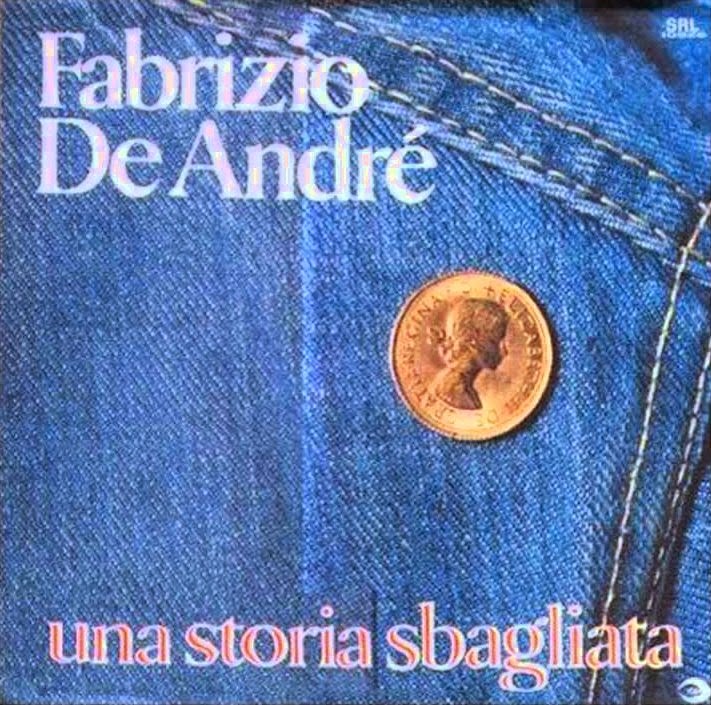
Album cover from Genova local Fabrizio De André
“In reclaiming the role of Genoa and Italy in the creation and development of jeans, the city has decided to disseminate its history and culture so as to return to being a commercial hub…” said Manuela Arata of GenovaJeans, a new annual international event that seeks to regenerate the city’s local jeans industry through a fresh generation of artisans and designers. With new jeans workshops and labs, jeans-based exhibitions, and other special projects across the city, GenovaJeans is just one in a series of initiatives the city is pursuing in order to regenerate its storied industry. Gradually restoring some of its historical significance as a key jeans production area in Genova, Via del Jeans is now home to dedicated workshops and spaces where artisans and designers can go to produce their wares. Genova–and Liguria–are looking to the future, to a new era in which bleu de Gênes will be sustainably designed and manufactured in the city and region where it all began centuries ago.
Genova is reclaiming its jeans; jeans as a creative canvas, jeans as a universal thread that unites us all, jeans you can walk all day and dance all night in. And so you should. Trust Adriano Celentano to sum it all up in a little jive tune from 1960, Blue Jeans Rock. Blue Jeans: an Italian icon… with a slight American twang. Now that’s bound to get the hips swinging.
“Blue jeans, blue jeans e rock’n’roll / C’è tanta gioventù con i blue jeans / Che balla il rock ‘n’ roll/ Yeah, yeah, yeah, yeah che balla il rock.”
(“Blue jeans, blue jeans and rock ‘n’ roll / There’s a lot of youth in blue jeans / Dancing rock ‘n’ roll / Yeah, yeah, yeah, yeah dancing rock.”)


